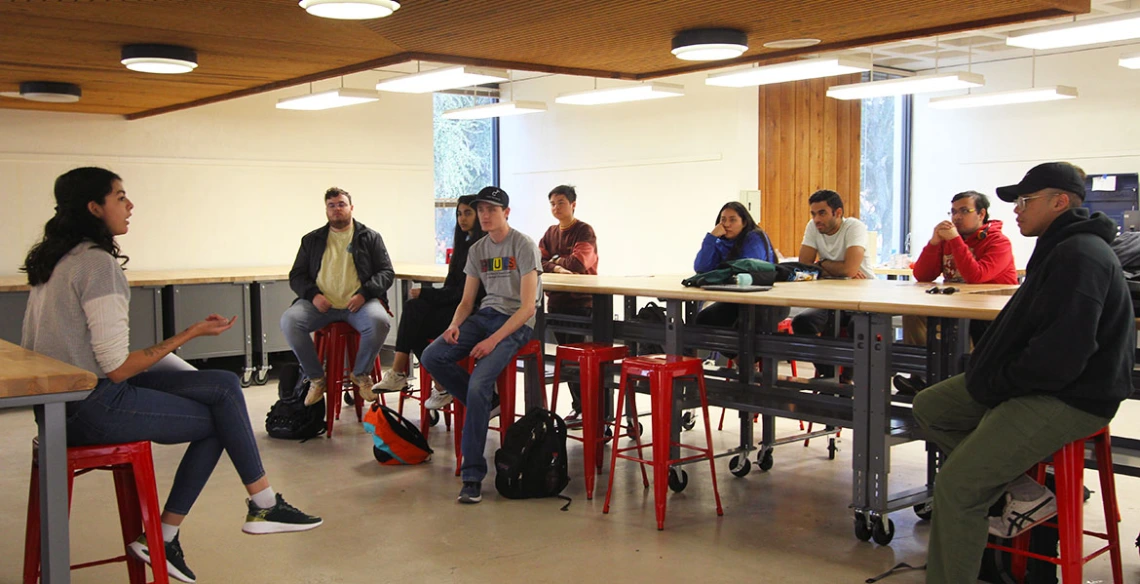Collegewide Makerspace Gives Capstone Teams a Home

Design technician Annissa Lopez, a senior majoring in environmental engineering, leads students
in an orientation and safety training at the Engineering Design Center.
With just a few months until Craig M. Berge Design Day, Interdisciplinary Capstone teams are doing their final building, tweaking and testing at a facility created for their needs. The Engineering Design Center, the first makerspace open to all College of Engineering students, has since February served as a hub for student teams to develop their capstone projects.
The 5,000-square-foot center, near the university’s Main Gate at Park Avenue and University Boulevard, provides 3D printers, work benches, power tools, storage lockers and more.
“All engineering students now have 24-hour access to a spacious, well-equipped, and safe place where they can collaborate and build,” said David W. Hahn, the college’s Craig M. Berge Dean. “The Engineering Design Center is advancing the college’s goals to provide the facilities our students need to succeed in and out of the classroom.”
Before the EDC opened, student teams could work in smaller, department-specific spaces, but they were not able to leave anything behind when the day's session was over. Moving project components, which can be large and heavy, to classrooms or homes placed a logistical burden on students, according to capstone faculty mentor Jim Sweetman.
“Each team needs this lab space,” said Sweetman, who is working with six teams. “The spring semester is fast paced, so the lab with all the resources in one place will be a tremendous time saver.”
The EDC offers space for student clubs to gather and work on projects and even for students to work on personal projects, but the largest need now is for Interdisciplinary Capstone teams.
Because teams are often made up of engineering students from various majors whose schedules don’t always align, the EDC is especially helpful.
The EDC has an electronics room for work on circuit boards and soldering, a light mechanical room with power tools such as a drill press and miter saws, and conference rooms where teams can meet with their clients and advisers.
Electrical and computer engineering student Lucca Magalhaes is part of a capstone team updating the design of a railcar sensor suite for maintenance detection. He says the opportunity to work on the U.S. rail system is a unique one.
The team is working with Ridgetop Group Inc. to replace obsolete or old parts of a railcar sensor system while maintaining energy consumption. The EDC will provide for many of the team’s hardware needs.

A faculty design committee helped choose the EDC’s equipment and tools.
“Our team plans to use the engineering space as a hub to use electronics lab equipment while also being able to access some features such as machine tools if we need to adjust our board design,” Magalhaes said. “It is not necessarily straightforward to come by a decent oscilloscope on the fly.”
While the EDC is open 24 hours, the power tools are only accessible when design technicians are present. These critical student workers provide safety instructions and training on how to operate equipment.
“They’re here to help teams,” said Larry Head, director of the Craig M. Berge Engineering Design Program. “They already have experience building, so they can provide a lot of support.”
Funding for the EDC’s equipment and three-year lease came from TRIF, the Technology and Research Initiative Fund, which is overseen by Research, Innovation and Impact at the University of Arizona, with a goal of supporting experiential learning toward growing the engineering workforce in Arizona.
Visionary Progress
The EDC serves as a precursor to the upcoming Student Design and Innovation Center. Within the next few years, the 100,000 square foot SDIC – 50% bigger than the Bear Down Building and with half the assignable footage of McKale Memorial Center – will become the public face of the College of Engineering.
The SDIC, prominently located on Speedway Boulevard, will provide collaborative classrooms and a student advising center, a home for student clubs and organizations, and building and design spaces for student projects and experiential learning. Fundraising is ongoing to bring this vision to life.

